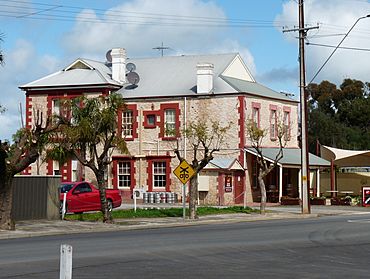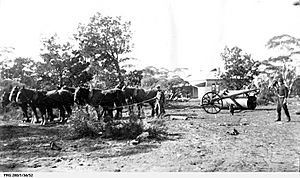Wasleys, South Australia facts for kids
Quick facts for kids WasleysSouth Australia |
|
|---|---|

Wasleys Hotel in 2010
|
|
| Postcode(s) | 5400 |
| Time zone | ACST (UTC+9:30) |
| • Summer (DST) | ACDT (UTC+10:30) |
| LGA(s) | Light Regional Council |
| State electorate(s) | Light |
| Federal Division(s) | Grey |
Wasleys is a small town in South Australia, located north-west of Gawler. It's about 6 kilometers (4 miles) south of Roseworthy College.
Contents
Discovering Wasleys
How Wasleys Got Its Name
The town of Wasleys is named after Joseph Wasley. He came to the colony of South Australia in 1838. Joseph was a successful miner at Burra and also in the Victorian goldfields. Later, he bought five sections of land in an area called the Mudla Wirra Forest. This area was established in 1847.
The name mudla wirra comes from the Kaurna language. Some people thought mudla meant "implement," suggesting the name meant "a forest where tools are found." However, experts like Norman Tindale believe mudla means "nose." This is based on early work by German missionaries Teichelmann and Schürmann, who wrote down Kaurna words in 1840. They recorded mudla as "nose" and mudli as "implement."
Smart Farming Ideas
After British colonisation of South Australia, some early farmers in the Wasleys area made important discoveries for Australian agriculture.
- In the 1860s, a farmer named Charles Mullen, who came from Ireland, invented a new way to plough land. This method was called "mullenising." He used a special tool known as a scrub roller or mallee roller. This invention was used all over Australia and was an early version of the stump-jump plough.
- From 1866 to 1877, farmer Richard Marshall experimented with different types of wheat. He also improved the soil using bone meal. His work helped to reduce a big problem called "red rust" in wheat crops.
The Railway Arrives
In 1869, the Peterborough railway line was built through the Wasleys region. A railway station was built on land that Joseph Wasley had bought. The railway was important for moving mallee roots, which were cleared from the land. In the same year, a post office with telegraph services was also opened.
Growing Up in Wasleys
In 1873, two townships were planned on either side of the railway line. One was called Ridley, and the other was Wasleys. George Thompson, a printer from North Adelaide, was in charge of planning Wasleys. By September 1873, Wasleys was fully laid out. A local newspaper wrote that it was "an excellent locality for a township." It was advertised as "Ridley Township - Wasleys Station" to attract people looking for good farming land. Later, these two areas became separate townships called Ridleyton and Wasleys.
A Wesleyan church was built in 1873, and a school started there the next year. Wasleys grew and became a busy place. At one time, there were three chaff mills, which processed hay for animal feed, but none of them are still around today. By 1909, the town had a wheelwright (someone who repairs wheels), several stores, and homes. It also had an Institute with a library. In 1928, Wasleys had 337 people, and a train went to Adelaide every day.
Important Events
On April 12, 1970, a bus crashed with a passenger train on the road from Wasleys to Gawler. Sadly, 17 people died, and more than 40 were injured.
In 2015, a large fire called the Pinery bushfire swept through Wasleys. It badly damaged the lawn bowls club and the post office.
Gallery






